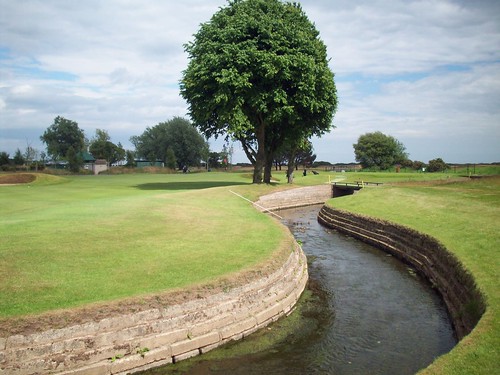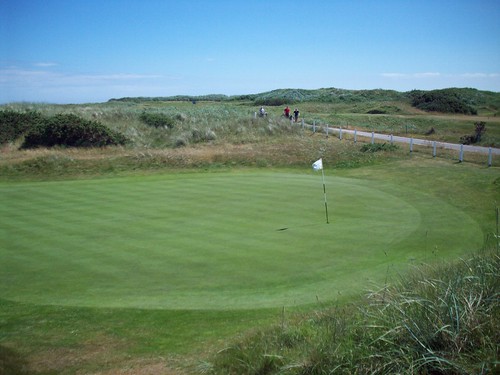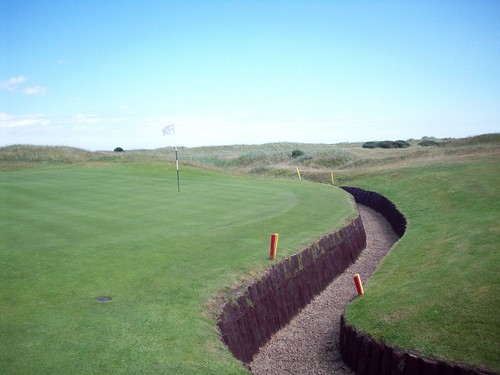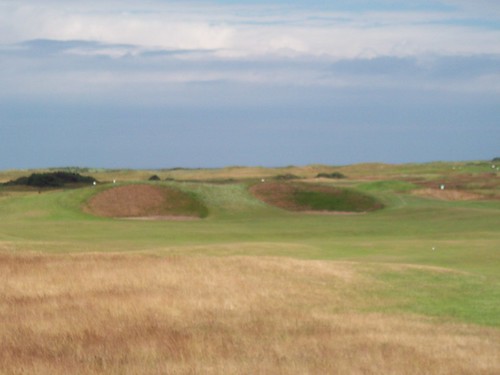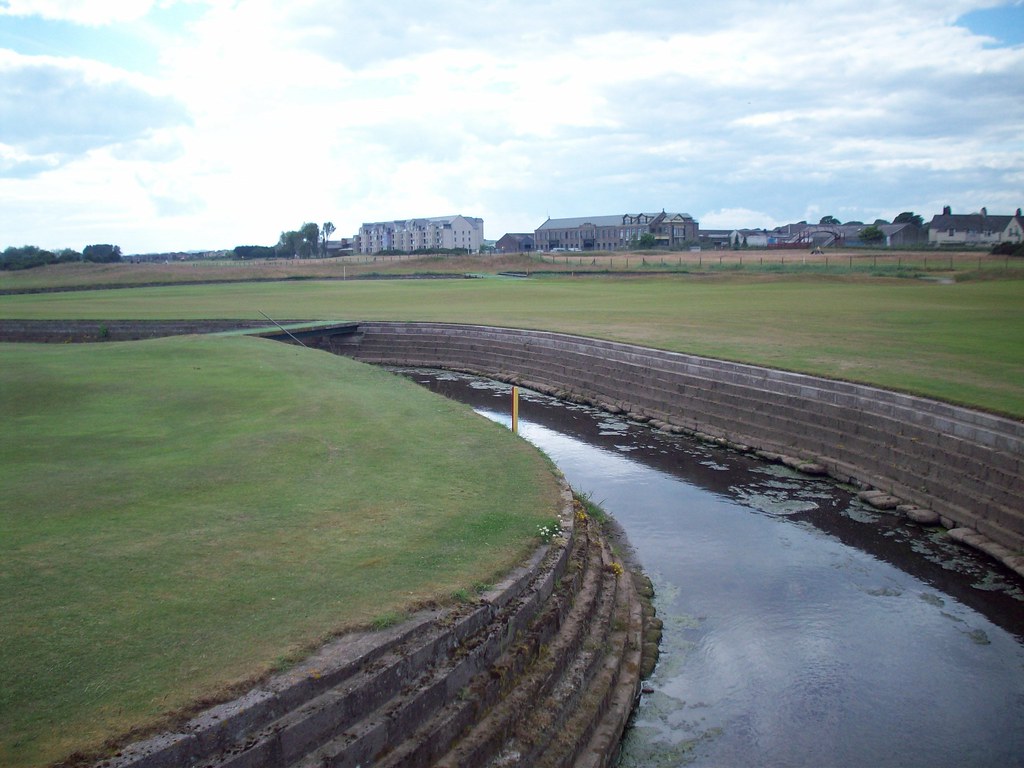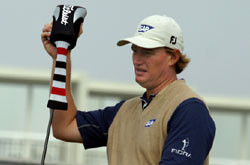Muirfield (ranked #3 in the world) is no mere golf club. It has a name that distinguishes it from all the rest of the top courses. There is no swimming pool here. This is not a Country Club in the American sense. No kids in the pool. No tennis courts. Just golf. This is the most formal course of them all; with a name that speaks volumes about the seriousness of the endeavor. The name of the golf club is The Honourable Company of Edinburgh Golfers. The course they play on is known as Muirfield.
Unless you are fully educated in the traditions of the game it is hard to appreciate how the Honourable Company of Edinburgh Golfers is different. The Honourable Company drew up the original 13 rules of golf in 1744. They are thus entitled to some amount of privilege. They were organized ten years before the governing body of golf in Britain - The Royal and Ancient. It is not like some of these newer ostentatious American clubs that try hard to give themselves history. The Honourable Company has real history.
Arranging to play at Muirfield is quite a chore. Getting on the course requires a precision in its planning closer to a military operation than booking a tee time. You don't just call and simply arrange a tee time on short notice. Such a dignified club guards their privacy and makes it difficult to get on. Most of the Open Championship courses in Great Britain aren't too difficult to get on if you plan ahead. In truth, it took several years to get a tee time at Muirfield, and even then, we had to book it over a year in advance and then built a golf trip around it. The good news is that once you get to play Muirfield they let you make a day of it and play 36 holes, provided you follow their rules. You can play your own ball in the morning if you'd like but in the afternoon you play alternate shot only.
Truth be told, Muirfield is now much easier to get information about in the last few years. It used to be very hard to even get their phone or fax number. Now, alas, they have entered the 21st century and even have their own web-site for bookings. They even have an email address. Check out their web-site for essentially a list of the word 'no' next to every available date.
http://www.muirfield.org.uk/index.cfm?action=visitorTeeTimesThe Honourable Company of Edinburgh Golfers does not have a professional's shop where a visitor can buy merchandise because the club has no professional. This suits them quite well since selling items would introduce an element of crass commercialism into the club that they quite suitably don't want. In fact, they really don't want visitors at all, but the prospect of charging (largely) Americans is apparently too much to resist. And we pay it willingly. It allows the members to essentially belong to the club for a low cost and invest the money back into the course. Visitors are only allowed to play on Tuesdays and Thursdays between 8:30 and 10:00 in the mornings, and then only off the tenth tee. Members and two-balls play off the first tee. They have a very distinct hierarchy of play and it must be adhered to.
Tee times are arranged through the Secretary of the club. Secretaries at Muirfield are legendary. Many have been former military commanders and thus they have a great deal of respect for rules and structure. Although the Secretary is appointed by a committee of the members, Muirfield Secretaries have traditionally behaved like it was their course. In their defense, they are trying to maintain order and structure. You have to be cautious when requesting a tee time not to overdo it. Like courting a woman, you have to go slow and judge each step carefully. Overdo it and you are shut out. Follow their protocol closely and look carefully for clues to get you to the next step. Booking a tee time is more like a master chess game.
One previous Secretary was known to use binoculars to monitor the golf course for any infractions. From his office, he could see most of the course. It is said that if you didn't rake the bunkers, he would be watching you and you would be reprimanded when you finished the round. It was something that all members feared. Members of Muirfield are important and powerful gentleman. They are leaders in the business community, the legal establishment, the government and the military. Yet, they all fear the Secretary of the Club.
There is another famous story about a Secretary at Muirfield where a group of non-members appear at the course one day. They are publicly recognizable figures, quite distinguished in their field. They ask for permission to play. The Secretary looks over the obviously deserted course and then replies that it would be impossible for them to play because the course was too busy. It is against this backdrop that you try to get on to Muirfield. It is no ordinary course to get on.
In any event, we had booked our tee time, and as luck would have it, it was on my birthday. As soon as you get a date reserved, I suggest calling the Greywalls hotel, which is immediately adjacent to Muirfield. It fills up quickly so you should book it right away since they don't have that many rooms. The Greywalls Hotel is symbiotic with Muirfield. Originally an Edwardian manor home for the Weaver family it was converted into a hotel in 1928. Since it was still affiliated with the aristocracy they provided it with a measure of privilege that has long been a tradition in Britain. To let you in on one of golf's great secrets, we learned while staying, that on Monday and Friday mornings there are an undisclosed set of tee times that are given to select guests of the Greywalls.
The Greywalls and Muirfield are hard to tell apart. There is even a secret doorway that connects the Greywalls to Muirfield. You can walk directly out the back door of the Greywalls and through a discrete and un-assuming door right into the clubhouse. You can see the Greywalls on TV when the British Open is held at Muirfield. It is right off the 10th tee. It effectively serves as a high-end dormy house for Muirfield. The walk from the hotel courtyard to The Honourable Company is less than 100 yards.
It was with great anticipation that we traveled south from St. Andrews to play Muirfield. As you are leaving the village of Gullane on the A198 traveling South you have to know where to turn left or you will not find Muirfield. You turn left onto Duncar road, yet there is no sign. Once you get the invite to play, you are informed of the situation and you are told where to turn. It looks like an alley-way or a service road. You have no idea you are next to one of the greatest golfing Meccas in the world. Once you make the left, you enter a road of about 500 yards in length. A sign halfway down the road warns you to turn away if you have no business related to the golf course. It doesn't say which golf course, as they don't want to give any clues so as to keep away the curious. You don't know it yet, but you are also being watched on a security camera.
Slightly further down the road on the right side of the road, hidden behind tall hedges are covered parking stalls. There are four small buildings hidden into the landscape. Car parks. Very discrete. It is befitting the majesty of the place not to have open car parks that would ruin the atmosphere. If there is a polar opposite to the public parking lots of a municipal course such as Bethpage, this is it. The extravagance of the parking lots tells you a lot about what is to come. About 100 yards further down the road are the discrete yet majestic stone entrance gates to the Greywalls. As you turn into the Greywalls, the crushed stone underneath the car adds to the feeling of grandeur. Once through the main gate you enter a courtyard with a further set of narrow stone gates that lead you through to the final entrance.
Our foursome awoke early the next morning. We had a full Scottish breakfast and were off for the short walk to the club. You approach the Muirfield gates and again notice a warning sign to step away if you have no business at the course. The black entrance gates are imposing and convey the appropriate sense of decorum. You unlatch a small gate and you enter on foot. You can't see the security cameras that are watching you, but you are being watched. You walk in and immediately see the first tee on the left, guarded by the caddy master. The course unfolds in front of you in a straightforward manner. The front nine forming the perimeter and organized in a clock-wise fashion. The back nine running counter-clockwise inside the back nine. And you begin to see the beginnings of what makes Muirfield so difficult - its bunkers.
There are no cameras or cell phones allowed on the property. The members jealously guard their privacy and their course. Ladies may only play if accompanied by a gentleman player and may not lunch in the Clubhouse.
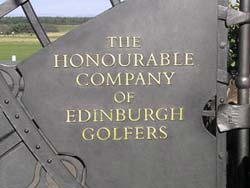
You are required to arrive at Muirfield in a jacket and tie. You walk past the clubhouse and into the drawing rooms, smoking rooms, etc. You are greeted as you walk by an Assistant Secretary who escorts you to the appropriate place within the clubhouse. You leave your bags outside the entrance and enter a foyer with an office on the left. Glancing in (you have to be careful not to stare) as you walk by you see one of the most imposing sights in golf: The desk of the Secretary of the Club at The Honourable Company of Edinburgh Golfers. It is a desk befitting the position. As imposing as anything you would see at #10 Downing Street or the Oval Office.
After you pass the Secretary's desk you come to a hallway that ends. To the left is the locker room, to the right a reception window and further on a smoking room and dining room. You stop at the reception window and have your credentials checked. Not unlike going through the customs process. No idle chit chat. No time for one-liners. Keep a somber look on your face and speak only when spoken to. You present your credentials in a business-like manner when you are asked. You must offer proof that you are worthy enough to play at the H.C.E.G. Your home golf club has previously provided a letter of attestation that you are not an inexperienced golfer off the street. You present your handicap cards and certificates to the women behind the counter. She verifies it against her log sheet to verify who you say you are. No computer generated lists here. A manual log, written in perfect script lettering. No substitutions allowed. You show up with the four golfers whom you said would play with or you don't play. No singles, no three-somes. You do as you are told and you're happy about it.
After being checked in you proceed to the locker room and change into your golfing attire. At the appointed time you proceed to the tenth tee and meet your caddies. Four balls (as a group of four golfers playing their own ball is properly called at Muirfield) proceed off the tenth tee only. The standard game at Muirfield is foursomes. Foursomes is a format where four golfers play with two balls only, alternate shot. The Honourable Company plays this format both because of tradition and because it is efficient. You can get a group around in two and a half hours.
After we played the 10th hole (our first) we were about to tee off on the 11th when our caddies became very flustered. Since we were the second group out that day, we were fortunate to have seasoned caddies. One of our caddies had noticed that the group behind us was four women. Women are not allowed to play without a gentleman at Muirfield. Their husbands were behind them on the 10th tee, planning to play as a group. 'If the Secretary sees this he will throw both groups off the course and fire the caddies', 'This is shite', 'No, No, No', were among the more polite things the caddies said. True to tradition, our most senior caddie went up to the group on the 10th green and made them split up. They had to mix up the two groups so that women were accompanied by men. At Muirfield, a rule is a rule.
After completing the morning round we proceeded into the locker room and changed back into jacket and tie to make our way to the member's dining room for a proper lunch.
Although the Scots are more properly famous for their full breakfast, lunch at the Honourable Company is an experience in indulgence. The dining room is oblong in shape and contains a series of long slender tables where you eat cafeteria style, although this doesn't capture the appropriate sense of decorum. It's rather like the prep school dining hall seen in the Harry Potter movies. Only with a lot more class. At the end of the room are giant glass windows overlooking the course. The walls are lined with pictures of every past captain of the Honourable Company.
The food is organized into five distinct sections, each representing a separate course: drinks and spirits; soup; carvery; cheeses and sweets. You sit at the galley tables and gorge yourselves. The room is quite steamy as the water baths from the vegetables and heat lamps from the carvery exude their heat. You wouldn't dare take off your jacket or loosen your tie for fear of being scolded. No matter how hot it gets, and it gets hot, you remain calm. Stiff upper lip. Never let them see you sweat.
It is the custom at the Honourable Company of Edinburgh Golfers that the captain of the club wears a red jacket. Much like you see a member of Augusta wearing their green jackets, at Muirfield, the tradition is old. The tradition evolved from when they originally played at Leith Links. At that time, all members had to wear their red jackets or could be fined. It subsequently evolved into only the captains wearing them.
After lunch we retired to the smoking room and sat in sumptuous leather chairs, again overlooking the 18th green. You sit and have more drinks and enjoy cigars and appreciate the splendor of both the room and the scene outside. At the far end of the room above the chimney piece is a painting of William St. Clair of Roslin painted in 1771. It is the centerpiece of the room and is sized proportionally for the large space. It is about 20 feet by 30 feet, painted in oil. William St. Clair of Roslin served as Captain of the Honourable Company of Edinburgh Golfers in 1761-1766, 1770 and 1771. The portrait reminds you more of a portrait of Mozart or George Washington than it does of a golfer. This is clearly a portrait of the 18th century. As you think that members of the Honourable Company were playing golf here before the time of the American revolutionary war, the history of the place begins to bear down on you. You don't need to be told about tradition sitting in this room. A moron could figure it out. Even most Americans.
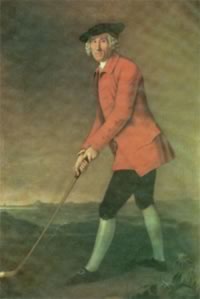
Mounted and framed in the smoke room they have a copy of the original thirteen rules at the club. Framed on the wall is also an original membership certificate for a member of the Leith Links, a predecessor club to Muirfield. The Honourable Company of Edinburgh Golfers is the name of the golfing society that has been in existence since 1744. The Honourable Company originally played at Leigh Links until they outgrew it. They then moved to Musselburgh, but soon outgrew that as well. Their third course is Muirfield and they are justifiably proud of their heritage.
Once you complete your relaxation you are back into the locker room to change back into your golfing attire and then you are off to your afternoon match. You are allowed to play your afternoon match off the first tee. The mandatory format is foursomes. As was typical given the unstable state of most golfers after the big lunch and drinks, so it was with our group. The first two shots were nowhere near the fairway and ended up in the knee high rough. The alternate shot format we played turned out to be one of the most fun and rewarding golfing experiences all four of us has ever had. What a great tradition. It is a shame that is has largely been lost.
And oh yea, the course was ok. Nothing spectacular when compared with dozens of other top ranked courses. Certainly, the bunkering is a defining characteristic. The scenery is honestly kind of bland; none of the holes are that memorable. You're not that close to the water. But the overall experience is one of the best you could have in golf. The history, tradition, respect, etc. In terms of the golf course itself, does it deserve to be ranked #3 in the world? Certainly not. But when you throw in the whole scene, you can begin to understand its esteemed place in the world of golf.
And while I normally don't like to recount shots and scores, I am particularly proud of my birdie at the #1 handicap hole. The 8th is a 443 yard, difficult par 4 dogleg with severe bunkering. It's Jack Nicklaus's favorite hole on the course, and now mine. I couldn't have asked for a better birthday present.
 Golf for beginners 01-29-06 episode twelve continues with our hole-in-one series as we discuss golfblogger.com's recent 140 yard, par-3 drop-in. No one was there to see it, he was not keeping score and it happened in the off-season.
Golf for beginners 01-29-06 episode twelve continues with our hole-in-one series as we discuss golfblogger.com's recent 140 yard, par-3 drop-in. No one was there to see it, he was not keeping score and it happened in the off-season.






